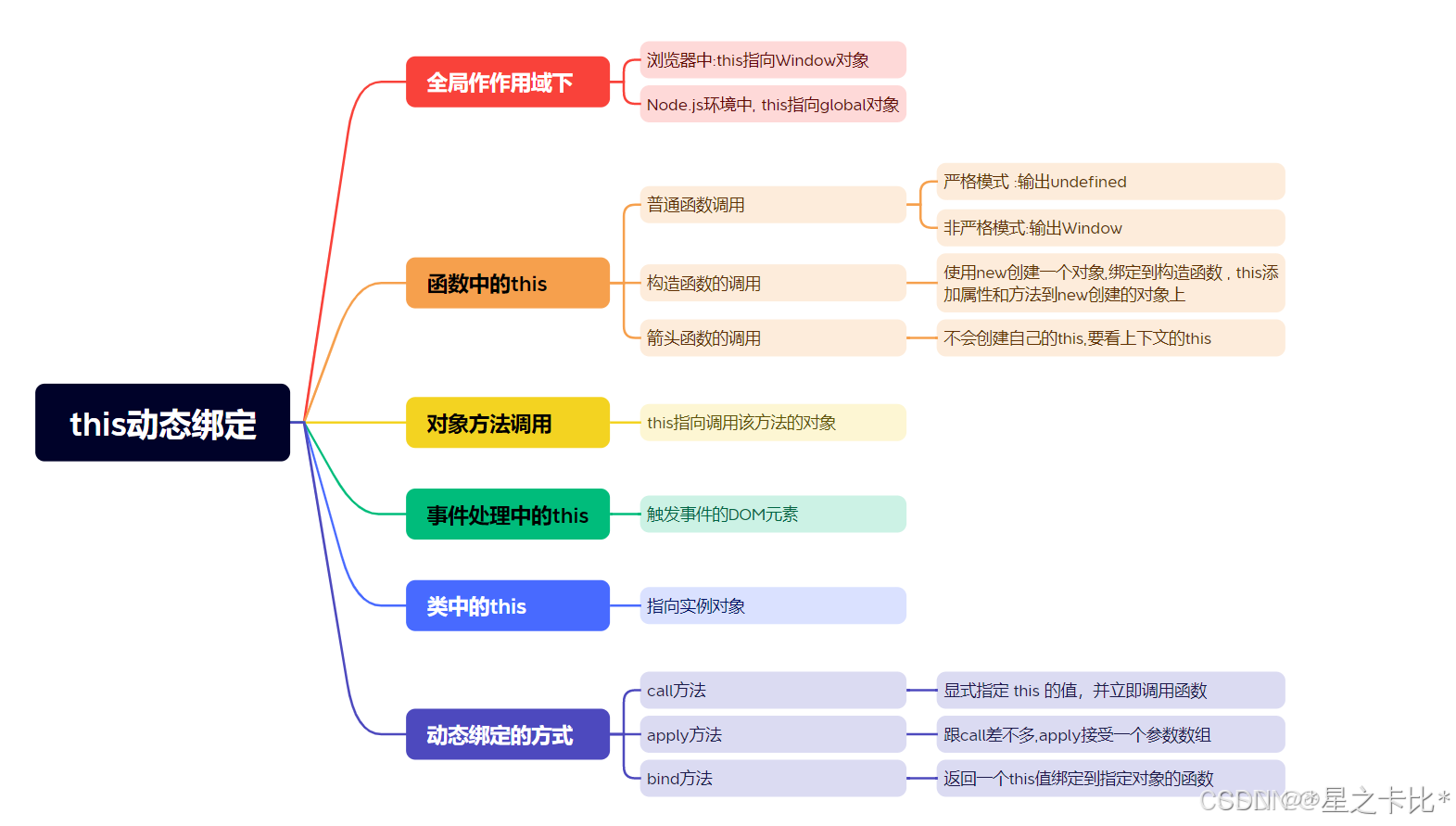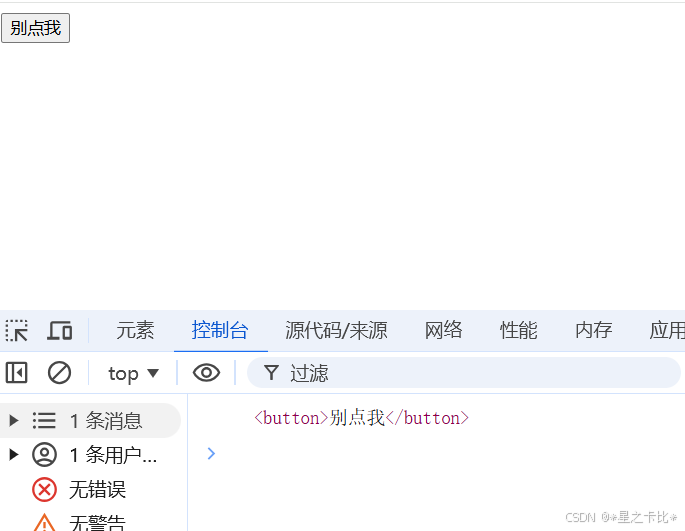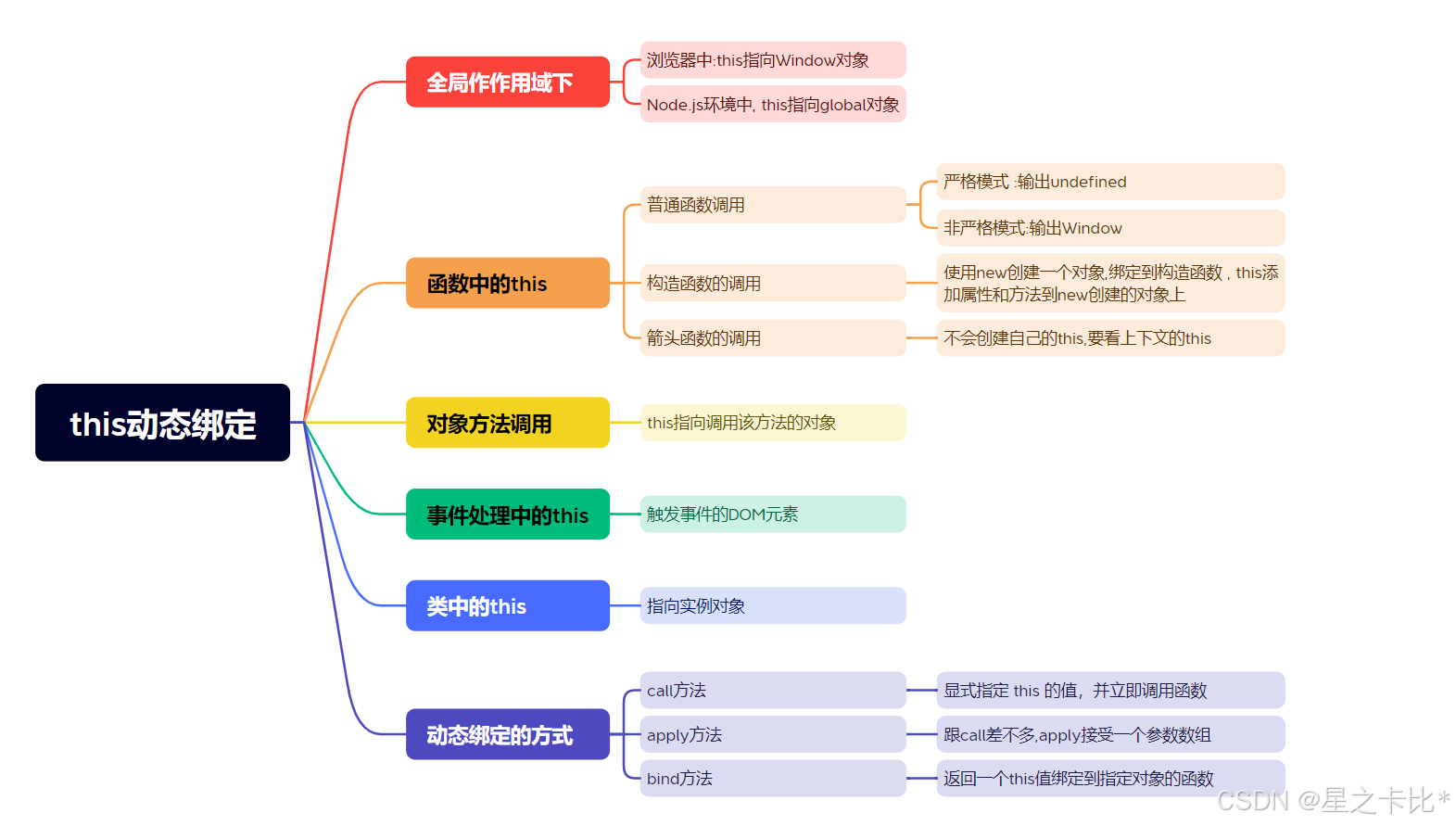
在JavaScript中,this 是一个非常重要但是呢 也让人难搞明白的关键字。
**它的值不是在编写代码时静态确定的,而是在代码运行时动态绑定的。**这非常重要
this 不是指向函数本身,而是指向 调用函数的对象。根据调用方式的不同,this 会指向不同的对象
下面讲一下它 .
在全局作用域中(即不在任何函数中),this 通常指向全局对象:
console.log(this);// 浏览器中输出 Window
console.log(this);// 在 Node.js 中输出:{} (指向 global 对象)functionshowThis(){
console.log(this);// 在 Node.js 中输出:{} (指向 global 对象)}showThis();
在严格模式(‘use strict’)下,this 在全局作用域中将是 undefined,而不是 window 或 global。
'use strict';
console.log(this);// 在严格模式下输出:undefined
this 在函数中的行为取决于调用的方式。
当函数以普通方式调用时,this 默认指向全局对象(在严格模式下是 undefined)。
functionfoo(){
console.log(this);}foo();// 浏览器中,this 指向 window
// 匿名函数setTimeout(function(){
console.log(this);//window},1000);
console.log(this);//window
在严格模式下:
"use strict";functionfoo(){
console.log(this);}foo();// undefined
当一个函数用作构造函数(通过 new 关键字调用 创建一个新的对象实例,并将该对象与构造函数绑定)时,this 指向新创建的实例对象(关键) , 用于将属性和方法绑定到该对象。
functionPerson(name){//创建一个构造函数 , 参数为namethis.name = name;//this指向当前创建的实例对象 , 新对象有个名为name的属性 this.name = name; 将参数 name 的值赋给对象的 name 属性。}const person =newPerson('Bob');
console.log(person.name);// 输出 'Bob'functionPerson(name, age){this.name = name;// this 绑定到新创建的对象this.age = age;}const person1 =newPerson('Alice',25);
console.log(person1);// Person { name: 'Alice', age: 25 }functionCar(brand, model){this.brand = brand;// 将 brand 绑定到新对象this.model = model;// 将 model 绑定到新对象this.getDetails=function(){return`${this.brand}${this.model}`;};}const car1 =newCar('Toyota','Corolla');
console.log(car1.getDetails());// Toyota Corolla
箭头函数不会创建自己的 this,它会继承来自其定义位置的外层上下文的 this。
const obj ={name:'Alice',arrowFunc:()=>{
console.log(this.name);}};
obj.arrowFunc();// undefined, 因为箭头函数中的 this 绑定的是全局对象
而普通函数会绑定到调用它的对象:
const obj ={name:'Alice',normalFunc:function(){
console.log(this.name);}};
obj.normalFunc();// 输出 'Alice'
使用箭头函数时,this 会继承自外层作用域:
函数作为对象的方法调用时,this 指向调用该方法的对象。
const obj ={name:'Alice',sayName:function(){
console.log(this.name);//this 指向调用该方法的对象,即 obj}// 应该是一个方法 是函数类型的方法};
obj.sayName();// 输出 'Alice'
this 在对象的方法中使用时,this 指向调用该方法的对象。
const obj ={name:'Alice',getName(){returnthis.name;}};
console.log(obj.getName());// 输出 "Alice"
const obj1 ={name:"Bob",greet:function(){
console.log(this.name);}};const obj2 ={name:"Charlie"};
obj2.greet = obj1.greet;// 将 obj1 的 greet 方法赋给 obj2
obj2.greet();// "Charlie"
尽管 greet 方法最初是定义在 obj1 上,但当我们将 greet 赋值给 obj2 后,调用 obj2.greet() 时,this 就指向了 obj2,而不是 obj1
在事件处理函数中,this 通常指向触发事件的 DOM 元素。
<button>别点我<button>
const button = document.querySelector('button');
button.addEventListener('click',function(){
console.log(this);// 输出被点击的按钮元素});

为什么要改变this的呢? 因为知道this的值一般不是我们想要的 , 比如箭头函数, 它没有自己的this . 所以下面讲一下 , 如何改变this的值 .
JavaScript 提供了三种显式绑定方法来改变 this 的值:(然而这仅仅是显式绑定)
想要详细了解:this四大绑定方式
call 允许你显式指定 this 的值,并立即调用函数。
call的语法 functionName.call(thisArg, arg1, arg2, …);
functiongreet(){
console.log(this.name);}const person ={name:'Alice'};greet.call(person);// 输出 'Alice'
apply 与 call 类似,只是它接收参数的方式不同
参数:
第一个参数:指定 this 的值(与 call() 一样,决定函数内部 this 的指向)。
第二个参数:是一个数组或者类数组对象,它包含了要传递给函数的多个参数。传递的是数组的元素 , 要明确细节概念
基本语法:
functionName.apply(thisArg,[arg1, arg2,...]);
greet.apply(person);// 输出 'Alice'
Math.max函数可以求出一些数字的最大值 但是参数只能是数字 , 不能是数组
如果想要求数组最大值 , 那就用展开运算符
var arr=[1,2,3]
console.log(Math.max(...arr))
然后转成数组就可以了
但是需要注意一个问题 展开运算符其实是ES6新添的 那Math.max函数在此之前只能是求一堆数字的最大值 , 功能有些鸡肋 , 那么当时的程序员是如何使用Math.max来最大值的呢 ?
console.log(Math.max.apply(null,arr));
第一个参数是空意味着不改变this. 把数组的元素作为了实参列表
等同于:
Math.max(arr[0], arr[2], arr[3])
<body><button id="btn">按钮 </button><div id="box"></div></body></html><script>classHomePage{
n=1;constructor(){let box=document.querySelector("#box")
box.innerHTML=this.n
let btn=document.querySelector("#btn")let that=this;//this 指向事件触发的元素,也就是按钮 btn。而不是 HomePage 类的实例。// 如果直接使用 this.n++,会报错,因为 btn 元素并没有 n 属性。只有this有 //为了解决这个问题,我们使用了 that = this;,//使得 that 保持了 constructor 中 this(即 HomePage 类的实例) 的引用。
btn.onclick=function(){
console.log(this);
that.n++;
box.innerHTML=that.n
}}}newHomePage()</script>
bind 方法与 call 和 apply 不同,它返回一个新的函数,该函数的 this 值绑定到指定的对象。
const boundGreet =greet.bind(person);boundGreet();// 输出 'Alice'//通过 bind() 创建了一个新的函数 boundGreet,这个新函数的 this 永久绑定为 person 对象。
在类的实例方法中,this 指向实例对象:
classAnimal{constructor(name){this.name = name;}speak(){
console.log(`${this.name} makes a sound.`);}}const dog =newAnimal('Dog');
dog.speak();// Dog makes a sound.

1-构造函数内部-new的时候创建的对象
2-对象方法的内部-谁调用方法,方法this的就是谁
3-箭头函数-没有自己的this,跟外部环境一致
4-事件处理函数-内部的this的,指的是绑定事件的元素(谁给添加的事件,里面的this就是谁)
5-普通函数-匿名函数-全局中-this都是window--(严格模式下面,普通函数内部的this是undefined)
提示:请勿发布广告垃圾评论,否则封号处理!!